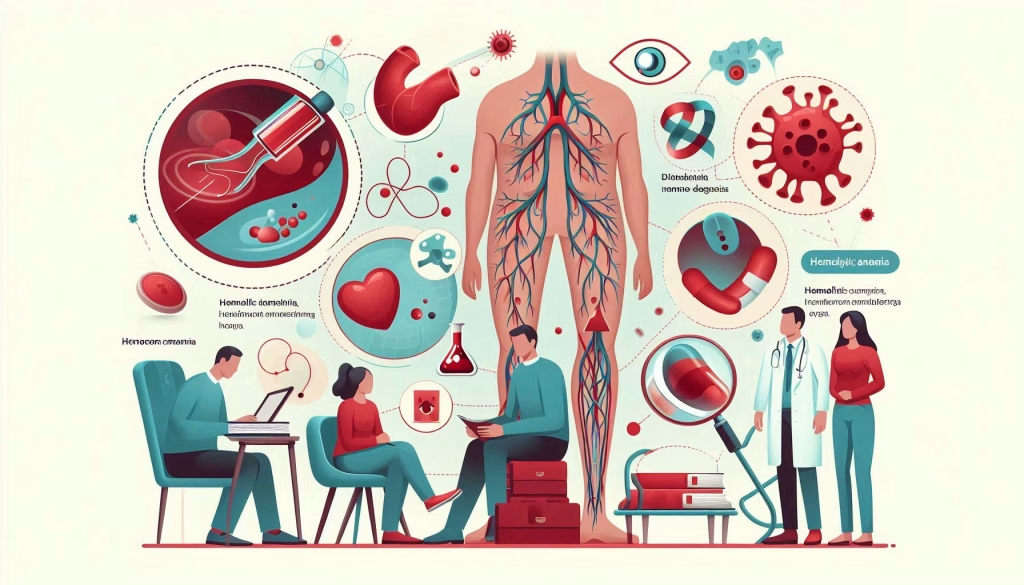Table of Contents
Overview
Occasionally, a deficiency of blood can manifest suddenly, causing dizziness or weakness. Despite the availability of numerous treatments for blood deficiency, it is often underestimated. However, this condition requires careful attention.
Anemia is not merely the condition commonly understood as a deficiency of red blood cells. In fact, there are various forms of anemia, including hemolytic anemia, which may not be widely known.
Hemolytic anemia is a condition where red blood cells are destroyed earlier than normal, leading to a reduction in their numbers. This rapid destruction outpaces the body’s ability to produce new red blood cells.
Anemia is a condition that requires serious treatment due to its potential to cause various complications, particularly in the heart, such as heart rhythm disturbances or heart failure.
Types of Hemolytic Anemia

| Endrinsic hemolytic anemia | Extrinsic hemolytic anemia |
| It is a condition when red blood cells are not formed. Or in other words, it doesn’t work perfectly. It is usually caused by genetic factors. For example, in patients with thalassemia and sickle cell anemia. | This type of hemolytic anemia is also often known as autoimmune hemolytic anemia. Extrinsic hemolytic anemia occurs because the spleen destroys healthy red blood cells. Red blood cell damage can also be caused by infections, tumors, blood transfusion reactions, lymphoma, leukemia, severe hypertension, or side effects of medications. Thistype of blood deficiency must be addressed immediately. Because, it can cause complications to the heart. Namely: heart rhythm disorders or arrhythmias, heart muscle abnormalities or cardiomyopathy including heart failure. |
Symptoms of Hemolytic Anemia
When hemolytic anemia is in its mild stage, it may not present any symptoms. Nevertheless, it is crucial to be aware of potential symptoms. The symptoms of hemolytic anemia can differ among individuals, but generally, those affected by hemolytic anemia may experience symptoms such as:
- Pale skin
- Fever
- Daze
- Sensation of drifting
- Experiencing fatigue or weakness to such an extent that one is incapacitated for physical activity.
- Dark urine fluid
- Jaundice is characterized by a yellow discoloration of the skin and the whites of the eyes.
- Heart palpitations
Know the Cause
It’s important to understand the causes of hemolytic anemia, as it can be categorized as a genetic or hereditary condition. This means that an individual may inherit this type of blood deficiency from their parents. Additionally, it can develop postnatally.
Besides hereditary or genetic factors, hemolytic anemia can be caused by various diseases, including thalassemia, hepatitis, leukemia, and tumors. Autoimmune conditions like systemic lupus erythematosus (SLE) and Wiskott-Aldrich syndrome can also lead to this condition.
Besides the diseases previously mentioned, hemolytic anemia may also result from side effects of certain medications. Drugs that can induce hemolytic anemia include acetaminophen, various antibiotics, ibuprofen, chlorpromazine, interferon alpha, and procainamide.
It is important to note that this form of anemia differs from the general type. Anemia, as commonly understood, results from a deficiency in red blood cells due to insufficient iron and can be remedied by boosting iron intake, including the consumption of vitamin B-12 and folic acid.
If the primary cause is identified, this disease can be effectively treated. However, when it reaches a chronic stage, hemolytic anemia may persist for an extended period. Chronic hemolytic anemia typically occurs in individuals who inherit it through genetic factors.
Diagnosis

To determine if someone has Hemolytic Anemia, a series of diagnostic tests must be conducted.
The initial step is to review your health history. Considering that this condition may arise from genetic or hereditary factors, the doctor will undoubtedly begin by investigating if any family members of the patient have suffered from anemia.
The subsequent examination aims to identify symptoms. The doctor will inspect the patient’s skin for signs of pallor. Additionally, the patient’s eyes will be checked for any yellowing.
An examination to determine the discoloration of the skin and eyes is crucial, as jaundice can often accompany hemolytic anemia.
The doctor will likely perform an abdominal examination, including palpation and compression, to detect any symptoms of liver or spleen enlargement. This is crucial as changes in the size of these organs may indicate hemolytic anemia.
When a patient exhibits symptoms suggestive of hemolytic anemia, the physician will perform a series of diagnostic tests. These tests typically include a complete blood count, bilirubin test, Coombs test, and bone marrow aspiration.
Treatment
Hemolytic anemia is treatable. However, the chosen treatment method depends on various factors, with the primary one being the underlying cause.
The treatment of hemolytic anemia will take into account the severity of the condition and the patient’s age. Furthermore, the overall health of the patient and their reaction to medication are critical factors to consider.
Some of the usual treatment methods to treat hemolytic anemia include:
- Red blood cell transfusion aims to raise the count of low hemoglobin (Hb) by replacing the red blood cells that have been lost or destroyed.
- Intravenous immunoglobulin (IVIG) involves the injection of immunoglobulins directly into a vein. This treatment is utilized when hemolytic anemia arises from an autoimmune disorder.
- Immunosuppressant drugs are used to decrease the activity of the immune system, thereby preventing the destruction of red blood cells.
- Folic acid and iron supplements

The Conclusion
Healthy Lifestyle
Maintaining a healthy lifestyle is crucial in preventing hemolytic anemia, similar to the measures taken during the COVID-19 pandemic, which primarily involve avoiding infections. Preventative measures include regular handwashing and toothbrushing. It’s also advisable to avoid direct contact with those who are infected and to minimize exposure to crowded places.
For individuals with hemolytic anemia resulting from medication side effects, avoiding certain drugs that may trigger it is advisable, as previously discussed. Preventing hereditary hemolytic anemia involves genetic counseling to assess the likelihood of the disease being passed from parents to offspring.
Do you think you have other ideas about Hemolytic Anemia: Early Signs, Diagnosis, and Effective Treatments? You can comment and share your thoughts below, or discuss more in the InsuranceWhat Forum. Also, read more articles about HEALTH INSURANCE or other interesting insurance topic articles only at InsuranceWhat.com.






